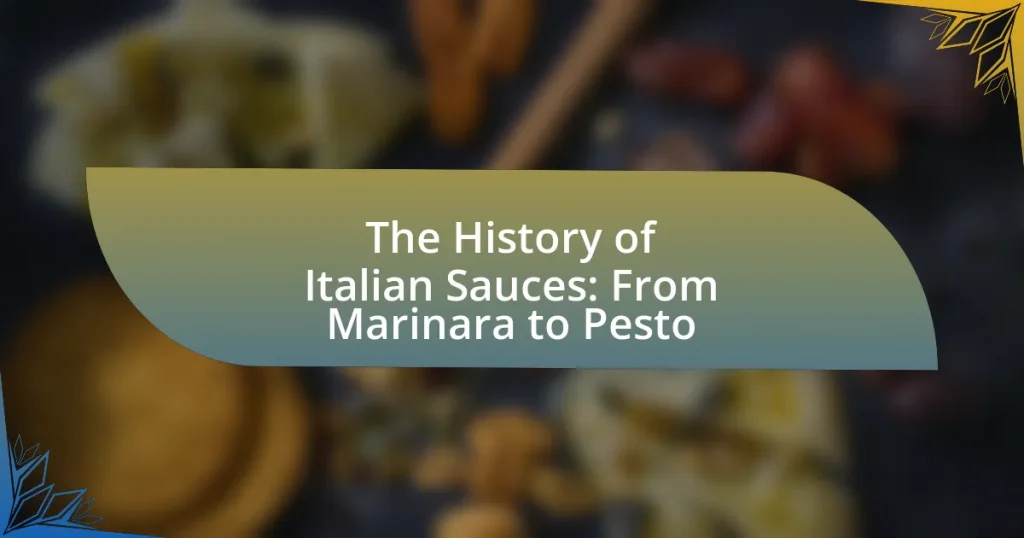The article explores the history of Italian sauces, tracing their origins from ancient Roman times to the present day. It highlights the evolution of sauces, particularly with the introduction of tomatoes in the 16th century, leading to iconic varieties such as marinara and pesto. The article discusses regional variations in sauce development, the role of sauces in Italian culinary traditions, and key types of sauces, including Bolognese and Alfredo. Additionally, it examines how modern dietary trends and innovations have influenced traditional recipes, emphasizing the importance of high-quality ingredients and preparation techniques in enhancing flavor.

What is the history of Italian sauces?
The history of Italian sauces dates back to ancient Roman times, where sauces were primarily made from ingredients like olive oil, vinegar, and herbs. Over centuries, regional variations emerged, with the introduction of tomatoes in the 16th century revolutionizing Italian cuisine, leading to the creation of iconic sauces such as marinara and puttanesca. By the 19th century, the industrialization of food production further diversified sauces, incorporating ingredients like cream and cheese, which gave rise to creamy sauces like Alfredo and Carbonara. This evolution reflects Italy’s rich culinary heritage and regional diversity, with each sauce embodying local ingredients and traditions.
How did Italian sauces evolve over time?
Italian sauces evolved significantly over time, influenced by regional ingredients, cultural exchanges, and culinary innovations. Initially, sauces like marinara emerged in the 16th century, primarily using tomatoes, which were introduced to Europe from the Americas. As Italian cuisine spread, sauces diversified; for instance, pesto originated in Genoa in the 19th century, combining basil, garlic, pine nuts, and cheese, reflecting local agricultural practices. The evolution continued with the incorporation of various herbs, spices, and techniques, leading to a rich variety of sauces that cater to different tastes and regional specialties, such as ragù in Bologna and puttanesca in Naples. This historical progression illustrates how Italian sauces adapted to changing tastes and available ingredients, solidifying their place in global cuisine.
What are the earliest known Italian sauces?
The earliest known Italian sauces include Garum, a fermented fish sauce used in ancient Roman cuisine, and Salsa, a mixture of crushed herbs and spices. Garum dates back to the 4th century BC and was widely used in various dishes, while Salsa, which evolved into modern sauces, was documented in Roman texts as a condiment for meats and vegetables. These sauces laid the foundation for the diverse range of Italian sauces that developed over the centuries.
How did regional variations influence sauce development?
Regional variations significantly influenced sauce development by incorporating local ingredients, culinary traditions, and climate conditions. For instance, the use of fresh tomatoes in southern Italy led to the creation of marinara sauce, while the northern regions, with their abundance of cream and butter, favored richer sauces like Alfredo. Additionally, herbs and spices unique to specific areas, such as basil in Liguria for pesto, shaped the flavor profiles of sauces, reflecting the agricultural practices and cultural preferences of those regions. This diversity in ingredients and techniques resulted in a wide array of sauces that are emblematic of Italy’s regional identities.
What role did Italian sauces play in culinary traditions?
Italian sauces are fundamental to culinary traditions, serving as essential flavor enhancers and cultural symbols. They provide depth and complexity to dishes, with varieties like marinara and pesto reflecting regional ingredients and cooking techniques. Historically, sauces have been integral in Italian cuisine, influencing meal preparation and presentation, as well as contributing to the identity of Italian gastronomy. For example, marinara sauce, originating from Naples, showcases the use of local tomatoes and herbs, while pesto from Liguria highlights the region’s basil and pine nuts, illustrating how sauces encapsulate local flavors and traditions.
How have sauces shaped Italian cuisine?
Sauces have fundamentally shaped Italian cuisine by serving as essential components that enhance flavor, texture, and presentation of dishes. The evolution of sauces, such as marinara and pesto, reflects regional ingredients and culinary traditions, influencing the overall identity of Italian cooking. For instance, marinara sauce, originating from Naples, showcases the use of tomatoes, garlic, and herbs, which are staples in Italian gastronomy. Similarly, pesto, hailing from Liguria, highlights the use of fresh basil, pine nuts, and olive oil, emphasizing the importance of local produce. These sauces not only define specific dishes but also represent the cultural heritage and diversity of Italy’s culinary landscape.
What cultural influences contributed to sauce creation?
Cultural influences that contributed to sauce creation include the Mediterranean climate, local agricultural practices, and historical trade routes. The Mediterranean climate allowed for the cultivation of diverse ingredients such as tomatoes, herbs, and olives, which are foundational to Italian sauces. Local agricultural practices, particularly in regions like Campania and Liguria, emphasized the use of fresh, seasonal produce, leading to the development of sauces like marinara and pesto. Historical trade routes facilitated the exchange of spices and cooking techniques, further enriching Italian cuisine. For example, the introduction of spices from the Middle East influenced the flavor profiles of various sauces, showcasing a blend of cultural culinary traditions.

What are the key types of Italian sauces?
The key types of Italian sauces include Marinara, Bolognese, Pesto, Alfredo, and Carbonara. Marinara is a tomato-based sauce often used with pasta and seafood, while Bolognese is a meat-based sauce originating from Bologna, characterized by its rich flavor and slow cooking process. Pesto, made from basil, garlic, pine nuts, Parmesan cheese, and olive oil, is a fresh sauce typically served with pasta. Alfredo is a creamy sauce made from butter, heavy cream, and Parmesan cheese, commonly paired with fettuccine. Carbonara, originating from Rome, combines eggs, cheese, pancetta, and pepper, creating a rich and savory dish. Each sauce has distinct ingredients and preparation methods that reflect regional Italian culinary traditions.
What distinguishes marinara sauce from other Italian sauces?
Marinara sauce is distinguished from other Italian sauces primarily by its simplicity and the absence of meat or dairy. It is typically made from tomatoes, garlic, herbs, and olive oil, focusing on fresh, vibrant flavors. Unlike sauces such as Bolognese, which include meat and a variety of vegetables, marinara is a quick-cooking sauce that emphasizes the natural taste of tomatoes. This sauce is often used as a base for pasta dishes and is known for its versatility in Italian cuisine, making it a staple in many households.
What ingredients are essential for marinara sauce?
Essential ingredients for marinara sauce include tomatoes, garlic, olive oil, and basil. These components form the foundation of the sauce, with tomatoes providing the primary flavor and texture, while garlic adds depth and aroma. Olive oil contributes richness, and basil introduces a fresh, aromatic quality. The use of these ingredients is rooted in traditional Italian cooking, where simplicity and quality are emphasized, making marinara sauce a staple in Italian cuisine.
How is marinara sauce traditionally prepared?
Marinara sauce is traditionally prepared by sautéing garlic in olive oil, then adding crushed tomatoes, salt, and herbs such as basil and oregano. This method has roots in Italian cuisine, where the sauce is often simmered briefly to maintain a fresh tomato flavor, typically for about 20 to 30 minutes. The simplicity of the ingredients reflects its origins as a quick sauce for pasta, emphasizing the use of high-quality tomatoes, which are essential for authentic flavor.
What makes pesto a unique Italian sauce?
Pesto is a unique Italian sauce primarily due to its distinctive combination of fresh basil, garlic, pine nuts, Parmesan cheese, and olive oil, which creates a vibrant flavor profile. This sauce originated in Genoa, Italy, and is traditionally prepared using a mortar and pestle, which enhances the freshness and aroma of the ingredients. The use of raw ingredients, particularly the fresh basil, sets pesto apart from many other sauces that are typically cooked. Additionally, pesto’s versatility allows it to be used in various dishes, from pasta to sandwiches, making it a staple in Italian cuisine.
What are the traditional ingredients of pesto?
The traditional ingredients of pesto are basil, garlic, pine nuts, Parmesan cheese, and olive oil. These components combine to create the classic Italian sauce known for its vibrant flavor and aromatic qualities. Basil serves as the primary herb, while garlic adds depth. Pine nuts contribute a creamy texture, and Parmesan cheese provides a savory richness, all emulsified with high-quality olive oil to achieve the desired consistency. This combination has been used in Liguria, Italy, for centuries, establishing pesto as a staple in Italian cuisine.
How has pesto’s popularity changed over the years?
Pesto’s popularity has significantly increased over the years, particularly since the late 20th century. Originally a regional specialty from Genoa, Italy, pesto gained international recognition in the 1980s and 1990s as Italian cuisine became more mainstream. The rise of food culture and the emphasis on fresh, homemade ingredients contributed to its widespread appeal. By the 2000s, pesto was commonly found in supermarkets and restaurants worldwide, with various adaptations emerging, such as sun-dried tomato and vegan versions. This trend is supported by market research indicating a steady growth in sales of pesto products, reflecting its established status as a popular condiment and ingredient in diverse culinary applications.

How do Italian sauces vary by region?
Italian sauces vary significantly by region, reflecting local ingredients, traditions, and culinary influences. For instance, in the northern regions like Lombardy and Piedmont, sauces often feature cream and butter, such as the famous Gorgonzola sauce, while in the southern regions like Campania and Sicily, tomato-based sauces like marinara and fresh herb sauces like pesto are prevalent. This regional diversity is rooted in historical agricultural practices; for example, the abundance of tomatoes in the south led to their widespread use in sauces, whereas the cooler northern climate favored dairy products. Additionally, the use of seafood in coastal areas influences sauces like the Sicilian ‘salsa di pesce,’ showcasing how geography and local produce shape Italian culinary traditions.
What are some notable regional sauces in Italy?
Notable regional sauces in Italy include Marinara from Naples, Pesto from Liguria, and Ragù alla Bolognese from Bologna. Marinara is a tomato-based sauce often enriched with garlic and herbs, originating in the Campania region. Pesto, made from basil, garlic, pine nuts, Parmesan cheese, and olive oil, is a staple of Ligurian cuisine. Ragù alla Bolognese, a meat-based sauce, is characterized by its slow cooking process and is traditionally served with tagliatelle in Emilia-Romagna. Each sauce reflects the local ingredients and culinary traditions, showcasing Italy’s diverse regional flavors.
How does the sauce from Naples differ from that of Bologna?
The sauce from Naples, primarily known as marinara, differs from Bologna’s sauce, known as ragù alla Bolognese, in ingredients and preparation methods. Naples’ marinara sauce typically consists of tomatoes, garlic, olive oil, and herbs, focusing on a fresh and simple flavor profile. In contrast, Bologna’s ragù incorporates ground meat, onions, carrots, celery, and often includes wine and milk, resulting in a richer and more complex sauce. This distinction highlights the regional culinary traditions, where Naples emphasizes a lighter, tomato-based sauce, while Bologna’s sauce reflects a heartier, meat-centric approach.
What ingredients are commonly used in Sicilian sauces?
Common ingredients in Sicilian sauces include tomatoes, garlic, olive oil, capers, olives, and anchovies. These ingredients reflect the Mediterranean influence on Sicilian cuisine, where tomatoes serve as a base for many sauces, while garlic and olive oil enhance flavor. Capers and olives add brininess, and anchovies contribute umami depth. This combination of ingredients showcases the region’s agricultural bounty and culinary traditions, making Sicilian sauces distinct within Italian cuisine.
How do modern interpretations of Italian sauces differ from traditional recipes?
Modern interpretations of Italian sauces often emphasize lighter ingredients and innovative flavor combinations, contrasting with traditional recipes that typically rely on rich, robust flavors and specific regional ingredients. For example, while traditional marinara sauce is made with tomatoes, garlic, and olive oil, modern variations may incorporate elements like roasted vegetables or spices to enhance complexity. Additionally, contemporary chefs frequently adapt sauces to accommodate dietary preferences, such as using gluten-free or vegan substitutes, which diverges from the classic formulations that adhere strictly to regional authenticity. This evolution reflects broader culinary trends towards health-conscious eating and global fusion, showcasing how Italian cuisine continues to adapt while maintaining its foundational elements.
What innovations have chefs introduced to classic sauces?
Chefs have introduced various innovations to classic sauces by incorporating modern techniques, unique ingredients, and fusion elements. For instance, sous-vide cooking has allowed for precise temperature control in sauce preparation, enhancing flavors and textures. Additionally, chefs have experimented with alternative ingredients, such as using avocado in pesto instead of traditional basil, which caters to dietary preferences and adds a creamy texture. Furthermore, the use of molecular gastronomy has led to the creation of sauces with unexpected presentations, like foams or gels, transforming the dining experience. These innovations reflect a blend of tradition and contemporary culinary trends, showcasing the evolving nature of classic sauces.
How do contemporary dietary trends influence sauce recipes?
Contemporary dietary trends significantly influence sauce recipes by promoting healthier ingredients and alternative flavor profiles. For instance, the rise of plant-based diets has led to the incorporation of ingredients like cashews and nutritional yeast in sauces, replacing traditional dairy components. Additionally, the demand for gluten-free options has resulted in the use of alternative thickeners such as cornstarch or arrowroot in sauces, rather than wheat flour. These shifts reflect a broader trend towards health-conscious eating, as evidenced by a 2021 survey indicating that 43% of consumers are actively seeking to reduce their sugar and fat intake, which directly impacts how sauces are formulated.
What tips can enhance the preparation of Italian sauces?
To enhance the preparation of Italian sauces, focus on using high-quality ingredients, such as fresh herbs, ripe tomatoes, and authentic olive oil. Fresh ingredients significantly improve flavor and authenticity, as seen in traditional recipes where the quality of tomatoes can elevate a marinara sauce. Additionally, allowing sauces to simmer longer develops deeper flavors, a technique often employed in classic Italian cooking. For instance, a Bolognese sauce benefits from slow cooking, which melds the flavors of meat, vegetables, and wine. Finally, balancing acidity with sweetness, such as adding a pinch of sugar to tomato-based sauces, can enhance the overall taste profile, a common practice in Italian cuisine to counteract the natural acidity of tomatoes.















